Introduction
Given present milling capacity in south Florida, a full six to seven months (October to April-May) are required to process approximately 400,000 acres planted to sugarcane. Sugarcane is grown in four counties (Glades, Hendry, Martin, and Palm Beach) in Florida, with the majority of the production area extending in a 30-mile-wide arc directly south and east of Lake Okeechobee (Figure 1). Some sugarcane must be harvested before achieving maximum sucrose levels to sustain early-season (October–November) milling operations. "Early maturing" varieties are preferentially harvested during this time, recognizing that they may not have reached their peak sucrose content, but may have higher sucrose content than other later-maturing varieties (Miller and James 1977).
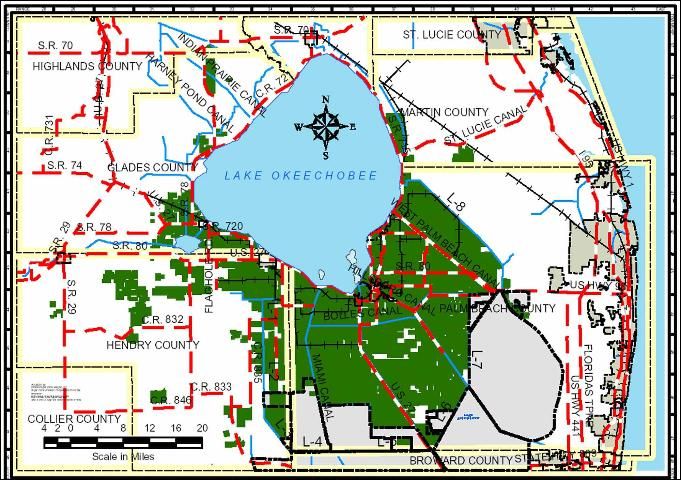
Researchers in South Africa (Bond 1982), Louisiana (Legendre 1985; Legendre and Fanguy 1975; Richard et al. 1981), and Mauritius (Mamet and Galwey 1999) have used information on sucrose content at the time of harvest to develop "maturity curves" for individual varieties. While the effect of variety on sugarcane sucrose accumulation rates has been well established, maturity curves for Canal Point (CP) sugarcane varieties have not been reported since 1977 (Miller and James 1977; Rice 1974). CP varieties account for greater than 80% of Florida sugarcane acreage and are also economically important (Tew 2003) in many countries, including Argentina (25% of total acreage), Belize (16%), El Salvador (50%), Guatemala (65%), Honduras (47%), Mexico (15%), Morocco (54%), Nicaragua (75%), Senegal (9%), and Venezuela (9%). Although most sugarcane growers in Florida plant a diverse selection of newer varieties, a lack of maturity curves makes it difficult to make informed harvest scheduling decisions. This fact sheet summarizes sucrose accumulation characteristics among some of the commercial CP varieties in Florida, Texas, and/or Central American countries to provide harvest scheduling recommendations.
Methodology
The data for this analysis were collected from experiments conducted at five locations (UF/IFAS Everglades Research and Education Center, Hundley, Lakeview, Sundance, and Hillsboro farms) in the Everglades Agricultural Area (EAA). Soil types included a Torry muck for the Lakeview location and Lauderhill muck for the remaining four sites. Harvest data were collected from October to March during 4 consecutive seasons (1998/1999 to 2001/2002). Harvest samples were collected at approximately 2-week intervals, commencing on October 14 of each season and ending by March 27 the following year. For this discussion, harvest dates within any given season represent the number of days after October 14. Maturity curves describing sugar per ton of sugarcane biomass (SPT, lb sugar/ton) at 25 (early-season; Nov. 8), 75 (mid-season; Dec. 28), and 125 (late-season; Feb 16) days after onset of harvest were developed for each variety.
Varieties were selected for this study based on either their economic importance (Glaz 2002) or recent release date until 2002. The first two digits in the variety name represent the year the variety was named, usually 7–10 years prior to variety release. Table 1 provides a brief description of the varieties included in this study. Although some of the varieties are phased out from Florida sugarcane industry, these are still cultivated in other states (Texas, Louisiana) or other countries (e.g., Guatemala, Nicaragua, Costa Rica) and are actively used as parents for crossing in Florida. Varieties are ordered by release date in tables and figures throughout this article.
Maturity Curves
"Early sugar" is an important characteristic that influences grower adoption of commercial germplasm. SPT values at the onset of the harvest season (October 14) are presented in Table 2. CP 80-1743, CP 88-1762, and CP 89-2143 were notable for their high initial SPT values, which were significantly greater compared to 10, 8, and 11 varieties, respectively, indicating that they would be good choices for October harvest in the EAA. In contrast, CP 88-1834 and CP 89-2377 had significantly lower initial SPT values than 11 of 12 varieties and thus would be poor choices for early harvest. Maturity curves were also used to calculate optimal harvest dates based on maximum SPT for each variety (Table 2). These dates ranged from January 26 (CP 80-1743 and CP 88-1762) to February 22 (CP 85-1382). Maximum SPT ranged from 267 lb/ton (CP 88-1834) to 308 lb/ton (CP 89-2143). Miller and James (1977) reported maximum SPT for 6 varieties at dates ranging from February 24 to May 17. The average maximum SPT for the 6 varieties in their study was 281 lb/ton compared to 279 lb/ton for the 13 varieties included in this study. It appears that maximum SPT for CP varieties has not changed greatly over the last 25 years, but the date of maximum SPT has shifted earlier in the harvest season. An exception to this is CP 89-2143, which has raised the standard for SPT levels significantly in recent years, causing lower SPT varieties to become less acceptable to growers.
Maturity curves for varieties included in this study are presented in Figures 2–4. CP varieties named from 1970–1979 are included in Figure 2, varieties named from 1980–1985 in Figure 3 and varieties named from 1986–1990 in Figure 4. At the first sampling date, CP 70-1133 SPT was greater than or equal to that of CP 72-1210, CP 72-2086, and CP 78-1628, but thereafter SPT for CP 70-1133 increased at a notably slower rate over time (Figure 2). In contrast, the SPT of CP 72-2086 exceeded these varieties during the late-season harvest period. CP 72-2086, used as a standard in the CP breeding program, is known for slow early-season growth, but has maintained its acreage in the EAA due to favorable late-season performance. CP 80-1743 recorded superior early-season SPT compared to other varieties named from 1980–1985 (Figure 3), but its relative SPT ranking decreased as the harvest season progressed. CP 89-2143 had clearly superior SPT compared to other varieties at all 11 sampling dates (Figure 4). CP 88-1834 and CP 89-2377 were notable for their poor SPT, particularly during the early season.
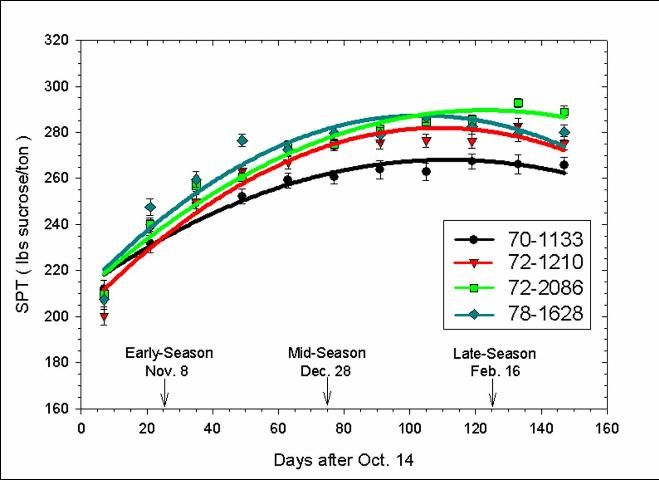
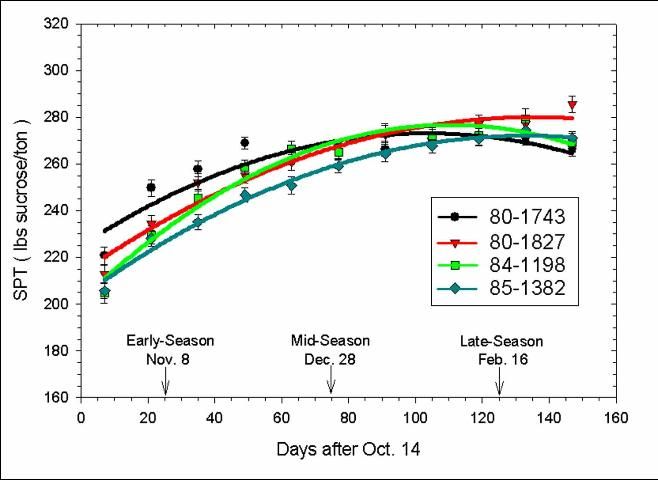
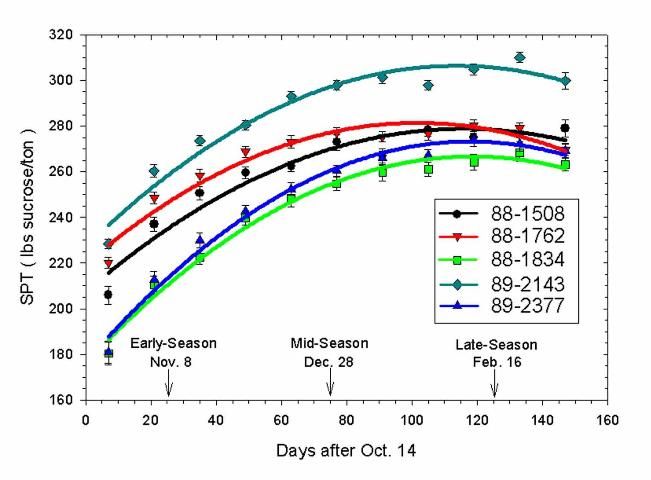
Harvest Recommendations
While the calculation of maturity curves for individual varieties is informative, the relative ranking of a given variety in comparison to others is required to optimize harvest scheduling decisions. Table 3 presents SPT for each variety for early-season (25 days after Oct. 14), mid-season (75 days), and late-season (125 days) harvest dates, along with the variety ranking for each harvest period. The final column represents harvest schedule recommendations based on the change in variety ranking over time. For example, since the relative ranking of CP 70-1133 was highest early in the season (rank=8) compared to mid-season (rank=10) or late-season (rank=12), CP 70-1133 receives an early-season harvest recommendation. Other varieties that are recommended for early-season harvest based on these criteria are CP 80-1743 and CP 88-1762. Varieties that had their highest rank in mid-season included CP 78-1628 and CP 84-1198. Late-maturing varieties included CP 72-1210, CP 72-2086, CP 80-1827, CP 88-1508, and CP 89-2377. The ranks of CP 89-2143 (first) and CP 88-1834 (last) remained consistent throughout all harvest periods. CP 89-2143 should be planted by growers interested in increasing the sucrose content of their sugarcane crop, while CP 88-1834 is a poor choice for sugar production in the EAA. While the consistently high rank of CP 89-2143 would suggest that it could be harvested throughout the season, its excellent post-freeze characteristics (Shine et al. 2001) compared to other commercial varieties indicate that it should be reserved for late harvest.
The most current grower census (Glaz 2002) indicates that the 3 varieties with the highest early SPT rankings, (CP 89-2143, CP 88-1762, and CP 80-1743), are also the varieties with the greatest expansion of plant cane acreage. In contrast, recently released varieties with poor early-season SPT (CP 88-1834 and CP 89-2377) have been planted on < 1% of the Florida sugarcane acreage. Varieties with < 1% acreage in the latest census (CP 72-1210, CP 85-1382, CP 88-1508, CP 88-1834, and CP 89-2377) had an average SPT of 188 lb/ton in mid-October, while the remaining 8 varieties in this study (with higher adoption rates) averaged 210 lb/ton. Growers are factoring SPT trends into their variety planting decisions. Maturity curve information contained in this fact sheet provides growers with a tool to make informed harvest scheduling decisions for these varieties.
Conclusions
Considerable genetic and temporal variability underlying sucrose accumulation trends was documented for CP sugarcane varieties. For the 8 CP varieties included in this study that are commercially grown in Florida, growers are advised to harvest CP 70-1133, CP 80-1743, and CP 88-1762 in the early season, CP 78-1628 and CP 84-1198 mid-season, and CP 72-2086 and CP 80-1827 in the late season. CP 89-2143 has superior SPT throughout the 5-month harvest season and should be planted by growers interested in increasing sucrose concentration of their sugarcane crop.
In addition to this summary article, fact sheets presenting more detailed variety-specific maturity curves are available on EDIS. If you are interested in the full-length journal version of this publication please refer to Gilbert et al. (2004).
Acknowledgements
The authors gratefully acknowledge the assistance of Mr. Robert Taylor, Mr. Matthew Duchrow, Mr. Vincent Sampson, and Mr. Henry Westcarth in sample collection and processing.
References
Bond, R. S. 1982. "Maturity differences between varieties in the selection programme." Proc. Ann. Cong. S. African Sugar Technol. Assoc. 56:136-139.
Gilbert, R. A., J. M. Shine, Jr., J. D. Miller and R. W. Rice. 2004. "Sucrose accumulation and harvest schedule recommendations for CP sugarcane cultivars." Crop Management.
Glaz, B. 2002. "Sugarcane variety census: Florida 2001." Sugar Journal. 65(3):35-39.
Legendre, B. L. 1985. "Changes in juice quality of nine commercial sugarcane varieties grown in Louisiana." J. Am. Soc. Sugarcane Technol. 4:54-57.
Legendre, B. L. and H. P. Fanguy. 1975. "Relative maturity of six commercial sugarcane varieties grown in Louisiana during 1973." Sugar Bull. 53(2):6-8.
Mamet, L. D. and N. W. Galwey. 1999. "A relationship between stalk elongation and earliness of ripening in sugarcane." Expl. Agric. 35:283-291.
Miller, J. D. and N. I. James. 1977. "Maturity of six sugarcane varieties in Florida." Proc. Am. Soc. Sugar Cane Technol. 7:107-111.
Rice, E. R. 1974. "Maturity studies of sugarcane varieties in Florida." Proc. Am. Soc. Sugarcane Technol. 4:33-35.
Rice, R., L. Baucum, and W. Davidson. 2015. "Sugarcane Variety Census: Florida 2014." Sugar Journal, July-2015, pp. 8-16.
Richard, C. A., F. A. Martin, and G. M. Dill. 1981. "Maturity patterns of several Louisiana sugarcane varieties." J. Am. Soc. Sugarcane Technol. 8:62-65.
Shine, Jr., J. M., R. A. Gilbert and J. D. Miller. 2001. "Post-freeze performance of 16 sugarcane cultivars following the December 31, 2000 freeze event in Florida." Sugar Journal 64(1):21-22.
Tew, T. L. 2003. "World sugarcane variety census—year 2000." Sugar Cane International March/April 2003:12-18.
University of Florida. 2003. Sugarcane Handbook. Gainesville: University of Florida Institute of Food and Agricultural Sciences. https://edis.ifas.ufl.edu/collections/book_sugarcane_handbook
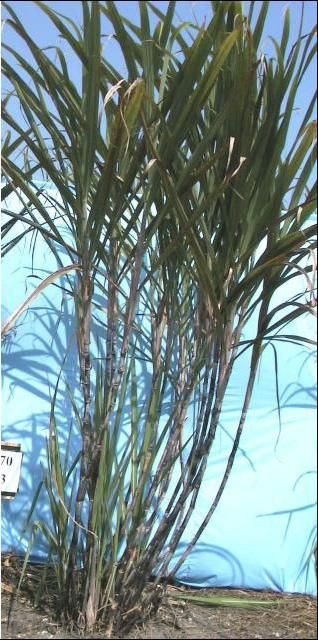
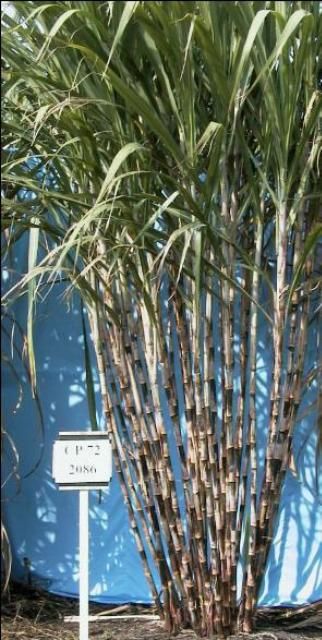
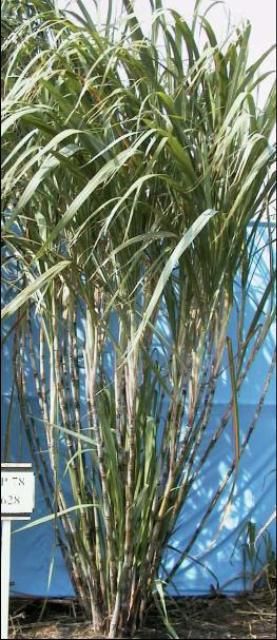
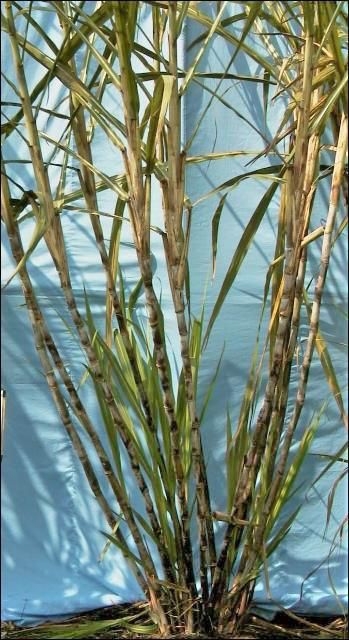
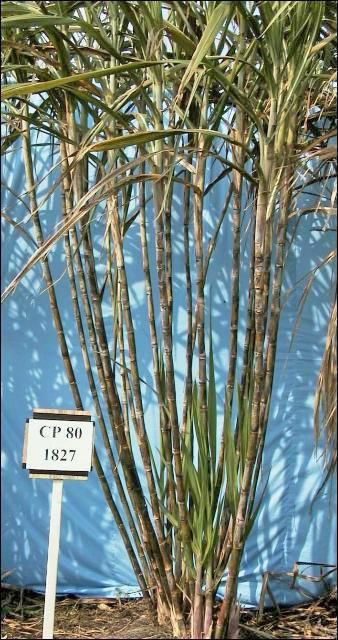

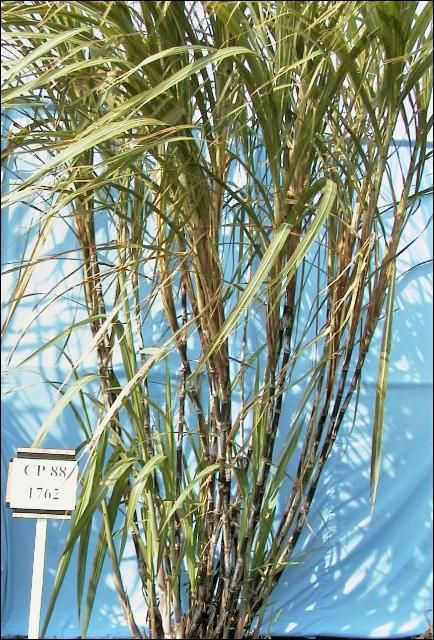
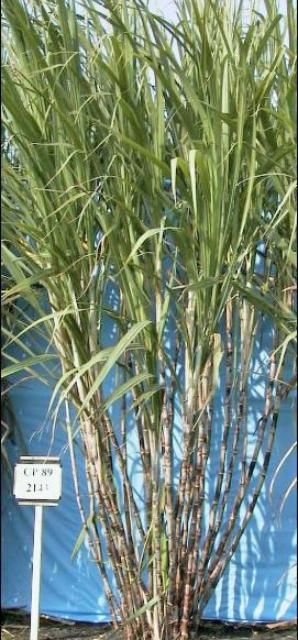
Sugar per ton (SPT) at harvest onset (October 14), maximum SPT, and estimated date of maximum SPT for recently released CP sugarcane varieties.